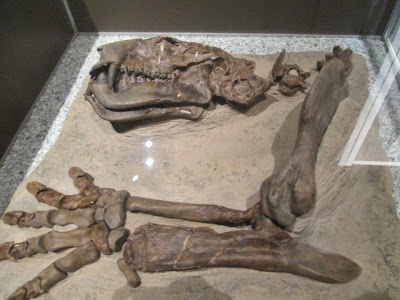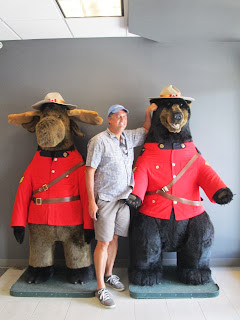Ron was down to 2 more days and nights before he had to catch a plane in Calgary to return to San Diego. Do you think he would just sit and relax? Not Ron, it is in his nature to keep moving.

We left Canmore very early in the morning and took Hwy 1 through Calgary then headed northeast on some small country roads until we reached the tiny town of Drumheller. Ron had picked out Dinosaur Provincial Park, located another hour away, to spend two nights and I had zeroed in on a museum in Drumheller that one of my guide books raved about. We decided to go to Drumheller first.

The drive was an amazing contrast in a relatively short distance from the land of majestic mountains and vast icefields to the prairielands of Alberta. The fields were alive with blooming rapeseed.

Rapeseed is the plant source for canola oil. The name 'Canola' is based on two things--Canada + ola. When the oil was first marketed their biggest competitor was Mazola oil. Maz-ola. I'm just glad they didn't choose Rape-ola.

We left Canmore very early in the morning and took Hwy 1 through Calgary then headed northeast on some small country roads until we reached the tiny town of Drumheller. Ron had picked out Dinosaur Provincial Park, located another hour away, to spend two nights and I had zeroed in on a museum in Drumheller that one of my guide books raved about. We decided to go to Drumheller first.

The drive was an amazing contrast in a relatively short distance from the land of majestic mountains and vast icefields to the prairielands of Alberta. The fields were alive with blooming rapeseed.

Rapeseed is the plant source for canola oil. The name 'Canola' is based on two things--Canada + ola. When the oil was first marketed their biggest competitor was Mazola oil. Maz-ola. I'm just glad they didn't choose Rape-ola.

We were starting to see signs of the Canadian Badlands along the rivers.

As we traveled along, the land would be perfectly flat and planted in lush green fields of alfalfa and rapeseed, when suddenly the ground dropped away....

....and enormous canyons opened up.
Seventy five million years ago dinosaurs roamed this very spot, foraging for food along the western shore of the Bearpaw Sea (the huge inland sea that is now gone). The dinosaurs vanished from the Earth 65 years ago, but they left behind, in Alberta, one of the most abundant fossil records in the world.

On August 12, 1884, Joseph Tyrrell, a geologist with the Geological Survey of Canada, while searching for coal, discovered a 70-million-year-old carnivorous dinosaur skull near present day Drumheller. Tyrrell's find was named Albertosaurus Sarcophagus ("flesh eating lizard from Alberta"). So significant was Tyrrell's discovery that when the Museum opened in September 25, 1985 it was named the
Tyrrell Museum of Paleontology.

A member of the Tyrannosaurus Rex family, Albertosaurus predated its more famous cousin by over two million years. Although smaller and more lightly built than T. Rex it was still a formidable predator.

The museum now houses more than 100,000 fossil specimens and more are being added daily, excavated from the surrounding Badlands.

Two high school students were fishing in the nearby Crowsnest Pass area in the summer of 1980 when they noticed a curious black fossil in the sandstone above the river. At first they thought it was fossilized wood but soon realized they had found a dinosaur. Excitedly they showed the specimen to a teacher who in turn reported it to the government of Alberta. After the arduous removal of over 500,000 pounds of rock, an incredible Tyrannosaurus Rex emerged.

This genus of mosasaur is extremely rare and this specimen is the first of its kind found so intact. Even more unusual than the nearly complete body are the stomach contents found inside--evidence that its diet included both sea turtles and large fish. Research on this animal is currently underway and scientists are working to determine whether or not it is a new species.
(This guy simply must be the predecessor to the alligator.)

Wendy Sloboda was 18 years old when she discovered what she thought might be fossilized eggshell along the Milk River Ridge. Her find prompted the Royal Tyrrell Museum to send a crew out in search of nests the following summer.
On the last day of fieldwork, a technician, Kevin Aulenback, sat to eat his lunch when he spied a piece of eggshell and a small femur nearby. He followed the trail of bones and shells to a nest eroding out of the hill. It was a defining moment in paleontological history. The fossilized nests, eggs and embryonic remains were from a new species of duckbilled dinosaur later named Hypacrosaurus Stebingeri.

After death, this Ornithohmymus body lay exposed under the hot Cretaceous sun. Theory suggests the flesh decomposed, muscles dried and ligaments tightened, pulling the skeleton into a dramatically arched position. Soon afterwards, sediment buried the body protecting its striking posture for millions of years.

...and another 'Death Pose.'

Work is ongoing as more fossils are liberated from the rock that encases them.

The work is long and arduous but the results are spectacular.


Ornithomimus

Large eyes and a slender neck allowed Ornithomimus to scan its surroundings quickly and efficiently. Armed with a sharp, narrow snout, this omnivore was well adapted to peck and rip both flesh and vegetation.

I have no idea.

Ammonites are extinct hard-shelled, coiled, squid-like marine creatures--abundant during the Mesozoic Era. They were plentiful prey for marine reptiles that inhabited the same Bear Paw Sea waters. In southern Alberta, some ammonites have a unique form of preservation. Tectonic pressure, heat, and mineralization over spans of millions of years compress them into colorful, iridescent material used to create jewelry called Ammolite. The ammonites preserved in this manner are both fossils and gemstones. Fragments of ammonites are found in open pit mines. While hoe operators claw carefully through the rock, trained 'spotters' watch for any glimmer of the organic treasures. This specimen, measuring over 2 ft in diameter, is the most brilliant ammonite ever recovered from Alberta.















































